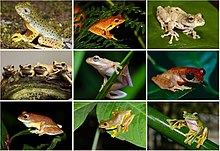| Rhacophoridae | |
|---|---|

| |
| Rhacophoridae diversity | |
| Scientific classification | |
| Domain: | Eukaryota |
| Kingdom: | Animalia |
| Phylum: | Chordata |
| Class: | Amphibia |
| Order: | Anura |
| Clade: | Ranoidea |
| Family: | Rhacophoridae Hoffman, 1932 (1858) |
| Subfamilies | |
The Rhacophoridae are a family of frogs in tropical sub-Saharan Africa, South India and Sri Lanka, Japan, northeastern India to eastern China and Taiwan, south through the Philippines and Greater Sundas, and Sulawesi. They are commonly known as shrub frogs, or more ambiguously as "moss frogs" or "bush frogs". Some Rhacophoridae are called "tree frogs". Among the most spectacular members of this family are numerous "flying frogs".
Although a few groups are primarily terrestrial, rhacophorids are predominantly arboreal treefrogs. Mating frogs, while in amplexus, hold on to a branch, and beat their legs to form a foam. The eggs are laid in the foam and covered with seminal fluid before the foam hardens into a protective casing. In certain species, this process occurs collectively. The foam is deposited above a water source, ensuring that the tadpoles drop into the water upon hatching.
The species within this family vary in size from 1.5 to 12 cm (0.59 to 4.72 in). Like other arboreal frogs, they have toe discs, and those of the genus Chiromantis have two opposable fingers on each hand. This family also contains the Old World flying frogs, including Wallace's flying frog (Rhacophorus nigropalmatus). These frogs have extensive webbing between their fore and hind limbs, allowing them to glide through the air.
Taxonomy
Evolution
The Rhacophoridae are the sister group to the Mantellidae, a family of frogs restricted to Madagascar. Both families are thought to have diverged during the Paleocene, although previous studies estimated a Cretaceous divergence. Two different hypotheses for this divergence have been proposed: one that the Mantellidae and Rhacophoridae diverged when Insular India broke from Madagascar, with the Rhacophoridae colonizing the rest of Asia following the collision of India with Asia, and the other proposing that the common ancestors of both families inhabited Asia, with the ancestral Mantellidae colonizing Madagascar from India via long-distance dispersal, using India as a stepping stone.

Genera
- Subfamily Buergeriinae Channing, 1989
- Buergeria Tschudi, 1838
- Subfamily Rhacophorinae Hoffman, 1932 (1858)
- Beddomixalus Abraham, Pyron, Ansil, Zachariah, and Zachariah, 2013
- Chirixalus Boulenger, 1893
- Chiromantis Peters, 1854
- Feihyla Frost, Grant, Faivovich, Bain, Haas, Haddad, de Sá, Channing, Wilkinson, Donnellan, Raxworthy, Campbell, Blotto, Moler, Drewes, Nussbaum, Lynch, Green, and Wheeler, 2006
- Ghatixalus Biju, Roelants, and Bossuyt, 2008
- Gracixalus Delorme, Dubois, Grosjean, and Ohler, 2005
- Kurixalus Ye, Fei, and Dubois, 1999
- Leptomantis Peters, 1867
- Liuixalus Li, Che, Bain, Zhao, and Zhang, 2008
- Mercurana Abraham et al., 2013
- Nasutixalus Jiang, Yan, Wang, and Che, 2016
- Nyctixalus Boulenger, 1882
- Philautus Gistel, 1848
- Polypedates Tschudi, 1838
- Pseudophilautus Laurent, 1943
- Raorchestes Biju, Shouche, Dubois, Dutta, and Bossuyt, 2010
- Rhacophorus Kuhl and Van Hasselt, 1822
- Rohanixalus Biju, Garg, Gokulakrishnan, Chandrakasan, Thammachoti, Ren, Gopika, Bisht, Hamidy, and Shouche, 2020
- Taruga Meegaskumbura, Meegaskumbura, Bowatte, Manamendra-Arachchi, Pethiyagoda, Hanken, and Schneider, 2010
- Theloderma Tschudi, 1838
- Vampyrius Dubois, Ohler, and Pyron, 2021
- Zhangixalus Li, Jiang, Ren, and Jiang, 2019
Phylogeny
This phylogeny of the Rhacophoridae is from Yu et al. (2008):
| Rhacophoridae |
| ||||||||||||||||||||||||||||||||||||||||||||||||||||||
Parasites
As many frogs, rhacophorids harbour monogenean worms in their urinary bladders. The parasite species specialized to this family of frogs belong to the genus Indopolystoma, described in 2019.
References
- ^ Zweifel, Richard G. (1998). Cogger, H.G.; Zweifel, R.G. (eds.). Encyclopedia of Reptiles and Amphibians. San Diego: Academic Press. pp. 99–100. ISBN 0-12-178560-2.
- Sunny Shah & Rachna Tiwari (2001-11-29). "Rhacophorus nigropalmatus, Wallace's Flying Frog". AmphibiaWeb. Retrieved 2007-06-22.
Edited by Tate Tunstall (2003-04-12)
- Li, Jia-Tang; Li, Yang; Klaus, Sebastian; Rao, Ding-Qi; Hillis, David M.; Zhang, Ya-Ping (2013-02-26). "Diversification of rhacophorid frogs provides evidence for accelerated faunal exchange between India and Eurasia during the Oligocene". Proceedings of the National Academy of Sciences. 110 (9): 3441–3446. Bibcode:2013PNAS..110.3441L. doi:10.1073/pnas.1300881110. ISSN 0027-8424. PMC 3587228. PMID 23401521.
- Feng, Yan-Jie; Blackburn, David C.; Liang, Dan; Hillis, David M.; Wake, David B.; Cannatella, David C.; Zhang, Peng (2017-07-18). "Phylogenomics reveals rapid, simultaneous diversification of three major clades of Gondwanan frogs at the Cretaceous–Paleogene boundary". Proceedings of the National Academy of Sciences. 114 (29): E5864 – E5870. Bibcode:2017PNAS..114E5864F. doi:10.1073/pnas.1704632114. ISSN 0027-8424. PMC 5530686. PMID 28673970.
- Robin Kurian Abraham; R. Alexander Pyron; Ansil B. R.; Arun Zachariah; Anil Zachariah (2013). "Two novel genera and one new species of treefrog (Anura: Rhacophoridae) highlight cryptic diversity in the Western Ghats of India". Zootaxa. 3640 (2): 177–189. doi:10.11646/zootaxa.3640.2.3. PMID 26000411.
- Yu Guohua, Rao Dingqi, Zhang Mingwang, Yang Junxing. Re-examination of the phylogeny of Rhacophoridae (Anura) based on mitochondrial and nuclear DNA. Molecular Phylogenetics and Evolution 50 (2009) 571–579. doi:10.1016/j.ympev.2008.11.023
- Chaabane, Amira; Verneau, Olivier; Du Preez, Louis (2019). "Indopolystoma n. gen. (Monogenea, Polystomatidae) with the description of three new species and reassignment of eight known Polystoma species from Asian frogs (Anura, Rhacophoridae)". Parasite. 26: 67. doi:10.1051/parasite/2019067. ISSN 1776-1042. PMC 6865761. PMID 31746733. [REDACTED]
- Cogger, H.G.; R.G. Zweifel; D. Kirschner (2004). Encyclopedia of Reptiles & Amphibians Second Edition. Fog City Press. ISBN 1-877019-69-0.
External links
- [REDACTED] Data related to Rhacophoridae at Wikispecies
- [REDACTED] Media related to Rhacophoridae at Wikimedia Commons
| Taxon identifiers | |
|---|---|
| Rhacophoridae | |